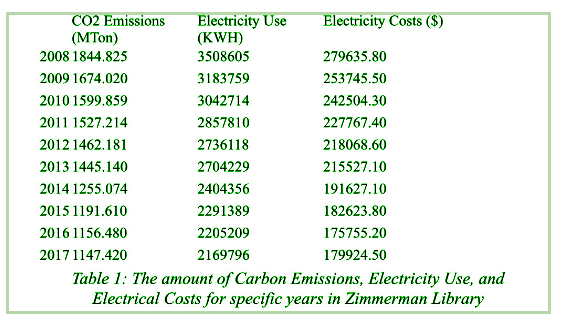By Gabriela Garcia-Huff, Brianna Mortensen, Jaden Torres / NM News Port /
The University of New Mexico Office of Sustainability set a goal in 2009 to decrease the university’s carbon emissions by 80 percent before the year 2030, according to the Climate Action Plan. However, with stagnant funding from the state and the regular traffic of single occupancy vehicles on campus, the university is falling short of its goals.
The Climate Action Plan is an initiative created by students in 2009 who came up with a list of sustainability projects and benchmarks for the university to meet within a 20 year timeframe. A statement released by the Sustainability Council summarized the plan’s purpose:
“These projects outline specific actions and goals that UNM can accomplish in five-year increments with a reasonable level of funding and technological advances,” the council said.

Bruce Milne, a UNM Biology professor and the director of the UNM Sustainability Studies Program said former UNM President David Schmidly signed an agreement in 2007 with the American College and University Presidents’ Climate Commitment (ACUPCC) that committed the campus to carbon neutrality.
“You had to agree to publish an audit of your carbon emissions every two years, but you didn’t have to specify when you were going to become carbon neutral,” he said. “At some point, you would have to also have a plan for how you were going to make progress” he said.
Milne took on this project and enlisted the help of one of his sustainability classes. Together, they composed the Climate Action Plan in hopes of eventually attaining carbon neutrality.
“Are we on target overall or not?” Milne said. “I think we should be scrupulous about that because otherwise, my fear is we won’t make necessary progress.”
Martin Santos is one of Milne’s sustainability students who recently analyzed Zimmerman Library as a sustainability model to measure progress made on UNM’s campus in accordance to the Climate Action Plan.
Santos said Zimmerman’s energy usage is not declining as quickly as originally predicted and is projected to reach 67 percent reduction in the year 2045.
“The Climate Action Plan wanted the whole campus to be at 80 percent he said. “This is just Zimmerman, and so looking at other pieces of data, more than likely, we’re not going to hit that.”
He also said that of all the buildings on campus, Zimmerman is one of the most energy efficient right now and it is still falling short of the outlined benchmarks.
“I am essentially calling for more action to be taken to reduce the footprint of our campus in order to create a better status for UNM,” Santos said.

“It’s a great example,” Milne said about Santos’s research.”It shows we’re lagging behind the 80 percent by 2030.”
Mary Clark, the director of the Office of Sustainability at UNM said these goals are currently unattainable because the university is growing, but the budget remains stagnant.
“We’re chugging along doing really good stuff based on the fact that we’re a state funded state university,” she said.
The Physical Plant Department is partially financed by the state through Instruction & General funding, and the rest of the funds come from the university budget. “We also receive money from the state for larger projects that are bigger than what we would consider maintenance type of work,” said Shirley Mitchell, the Associate Director of UNM’s Finance & Services Division. “We receive $5.6 million and that is used for projects on both Main Campus and the HSC (Health Sciences Center).”
These funds are directed toward instruction and general buildings every year, based on the square footage of buildings. The maintenance and the utility costs of the buildings as well as funding for non-instructional buildings, comes right out of UNM’s pocket, Clark said.

“Since 2008, the money we’ve received from the state has remained stagnant even though we’ve added new buildings and new square footage,” Clark said. All of this money is coming out of the Physical Plant Department’s budget, she said, which has caused them to lower their staff employment.
“We go every year and petition to the state,” she said, but the money for higher education and to maintain UNM buildings has not changed in recent years.
“It’s hard. It’s very hard,” Clark said. “Higher ed is getting harder and harder to finance.”
Listen to the Podcast recorded by News Port’s Gabriela Garcia-Huff for her UNM Communication & Journalism course.
Hi, I’m the (first-ever) Professor of Practice in Journalism at University of New Mexico in Albuquerque. So I’m very involved in helping students learn multimedia journalism. Before New Mexico, I was the 2012-2013 Reynolds Chair in Ethics of Entrepreneurial and Innovative Journalism at the University of Nevada, Reno… and, before that, a 2011 Knight Journalism Fellow at Stanford University. I’m also very active as a consultant, having spent over 25 years as a news director. My website is http://www.mikemarcotte.com or on Twitter: http://twitter.com/michvinmar